
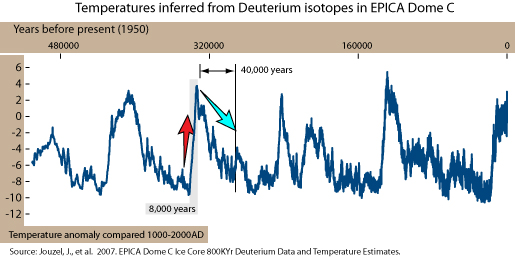
Warren Meyers, writing in Forbes magazine (Forbes 2/9/12), argues that breaking the theory of AGW into three parts undermines the potency of the often cited 97% consensus (Science, 03 December 2004):
Part 1) doubling CO2 induces global warming of 1 degree C.
Part 2) CO2-based warming will be amplified by feedback effects.
Part 3) the results will be bad for civilization.
Meyers argues that the 97% consensus is valid for part 1, but breaks down when parts 2 and 3 stand apart. Yet, his support for this censensus breakdown diverges from what a careful reading of the climate change literature would offer. He also takes on the more difficult position of proving negatives, and so additional information from the peer-reviewed literature should move his conclusions toward the conservative direction. (By "conservative," I mean, if you have a mild interglacial that has been conducive to civilization and prosperity, don't mess with it.)
Before celebrating our agreement on Part 1, it should be noted that 1C per doubling of atmospheric CO2 may be an underestimate and that 1.2 C may be more accurate (Hansen and Sato). Whether the value is 1 or 1.2, this is no small change for two reasons:
1) we are near 1C already, leaving little breathing room, and
2) Hansen makes a plausible case that ice core climate reconstructions have overestimated the ultimate warmth of the previous interglacials, thus we had less breathing room than we may have counted on if we are to preserve our mild interglacial climate.
Since Meyers' article is published in Forbes business magazine, perhaps I can compare this to financial investment: Have my advisors thoroughly apprised me of the risks before I invest in a warmer Earth? Do I want to be cautious (overestimating the risks) or daring (underestimating or disregarding the risks)? Think of risks as Earth's feedback effects, Meyers' Part 2.
On Part 2, that CO2-induced warming is accompanied by feedbacks, Meyers and I diverge on our reading of the scientific literature and on where to apply caution or engage in risk.
Meyers: "IPCC assumed that strong positive feedbacks dominated" and "catastrophic global warming advocates are wrong to over-estimate our understanding of these feedbacks"
The IPCC did not assume. It summarized the body of scientific literature which, using many different lines of evidence over many different time frames, concluded that the empirical evidence overwhelmingly suggests that warming induces positive feedbacks (see also Skeptical Science, Climate Sensitivity). A look at the palaeoclimate record reinforces this:


These data show a repeating pattern: Global cooling walks a gradual pace (blue arrow), often taking four times as long to reverse the onset of warming (red arrow). Thus, warming related feedbacks are more abrupt, and should be more disturbing to anyone looking for a safe, long-term investment.
A good investor would try to understand why risk-associated changes occurred. E.g., why did global climate snap out of a glacial era and create warm interglacials? Orbital changes in tilt and precession (Huybers, Nature, 08 Dec 2011) offer likely destabilizing triggers. The onsets (gray highlights) of the past four interglacials coincide with orbital changes that brought an increase of sunlight (red) to the northern hemisphere while the global sunlight (black) changed little.

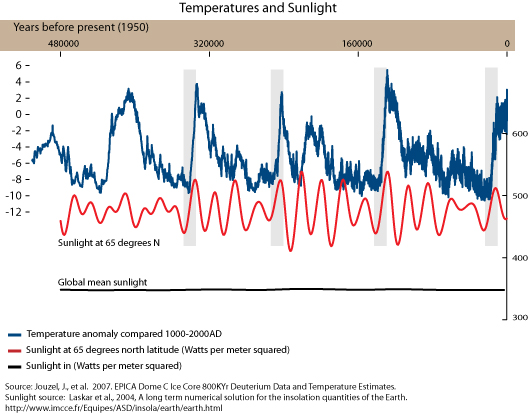
The black line represents total mean insolation and is important in understanding Earth's portfolio of warming-related feedbacks. These data show that Earth is extremely sensitive to changes that merely redistribute energy, in this case, by warming the northern hemisphere. There was fractional net gain in total energy (less that 1 W/m2), yet interglacials occurred with rapid onset. To get Biblical: Warming begets warming. If a long slow wobble (precession) was sufficient for Earth's feedbacks to raise the global temperature 8-12 degrees, we should be cautious, wary, risk-adverse of a global disturbance of 1 degree C, as this one degree disturbance occurs on top of an interglacial.
Meyers also underestimates another significant risk in Earth's feedback portfolio, how clouds will respond to warming.
Meyers: "On the other hand, water evaporated by rising temperatures may form more clouds that shade the Earth and help to reduce temperatures. Whether future man-made global warming is catastrophic depends a lot on the balance of these effects."
Meyers has missed an opportunity to point out that scientists are studying the cloud and water vapor angles (e.g., Dessler, 2010; Dessler and Sherwood, 2009). According to Schmidt et al. (Journal of Geophysical Research, 2010), clouds account for approximately 25% of the greenhouse effect. So, while Meyer cites the cooling effect of clouds, he fails to mention 25% of the greenhouse warming effect.
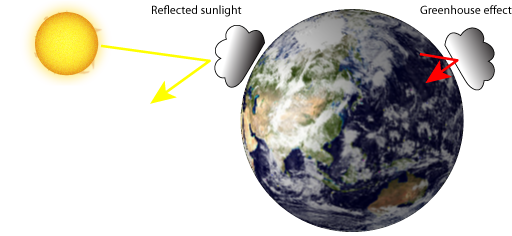
And what is the current understanding of clouds? Dessler (Science, 10 Dec. 2010) demonstrates that the cloud feedback effect over 2000 – 2010 has been slightly positive, 0.54 +/- 0.74 W/m2, and thus "a small negative feedback effect is possible but one large enough to cancel the climate's positive feedbacks is not supported" -- Dessler. This, however, is not a resolved issue, so a conservative interpretation is that as far as we know, clouds do not appear to be a negative feedback needed to counter warming, and it's too early to used clouds as a variable to dismiss the impact of global warming.
The other key feeback that Meyers omits is the water vapor feedback. Per Dessler and Sherwood (Science, 20 February 2009), "the water vapor feedback is is virtually certain to be strongly positive, with most evidence supporting a magnitude of 1.5 - 2.0 W/m2 per degree of warming."
So, considering clouds are neutral, and water vapor feedback well-established, I think the risk is most succinctly put by Meyers's own words:
Meyers: "Whether future man-made global warming is catastrophic depends a lot on the balance of these effects"
Hence, Meyers has framed the question to answer itself, but not yet put in all the data.
Risk could be swept aside if we had reason to believe that rising CO2 levels were not affecting Earth's energy budget. To this effect, Meyers makes his most flawed claim: that the missing heat from Earth's energy budget has not been found in the oceans. In fairness, it's difficult to say something isn't happening. It means he has to survey all the literature for lack of proof, and then monitor for new developments. In this case, current research is finding the missing heat in the oceans (NOAA) where it has the potential to create and sustain a new climate regime, one that may not mesh with our immense investments in water storage, agricultural, transportation and coastline infrastructure.
It's probably not necessary to critique Meyers's part 3, that warming must be bad, for our difference over part 2 is sufficient. However, in looking at the future, we should ask whether we want to be risk prone or risk averse. Skeptical Science has covered this topic (See "It's not bad"). Warming creates feedbacks that amplify warming. And, the data show that warming increases atmospheric CO2, likely through thawing of high latitude permafrost, changes in how the ocean absorbs or stores CO2, and changes in soil chemistry. Reconstructions of temperatures and CO2 levels from ice cores support this.

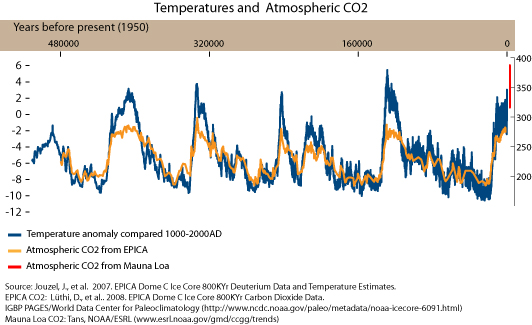
We are near one degree over Holocene and should expect feedbacks. If nothing else, the risk-adverse among us must admit that we are charting new territory. Earth's CO2 portfolio has been spiked by humanity's ingenuity. The level we've reached, 390 ppm, departs from any level pulled from 800,000 year ice, and yet current trends project concentrations to rise to 600 ppm in 70 years (Four degrees and beyond). Would you invest in this planet without a better understanding of what is happening?
 ----------------
----------------
UPDATE: In response to comments, I've removed an illustration comparing CO2 and temperature over the past 160,000 years (See Eric's comment 25 and my comment 34). In it's place I've added this chart from the IPCC Fourth Assessment Report showing plausible surface temperatures from various emissions scenarios.
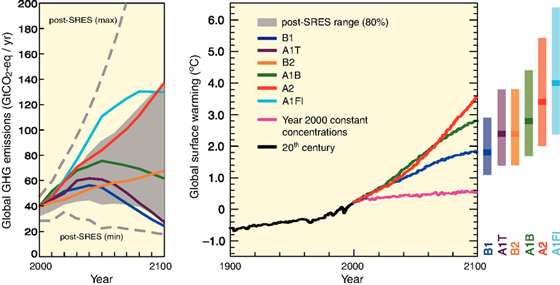
Figure SPM.5 from IPCC AR4. ?Scenarios for GHG emissions from 2000 to 2100 (in the absence of additional climate policies) and projections of surface temperatures? relative to 1980–1999. (See link for full description of the chart.)
Posted by jg on Wednesday, 22 February, 2012
 |
The Skeptical Science website by Skeptical Science is licensed under a Creative Commons Attribution 3.0 Unported License. |